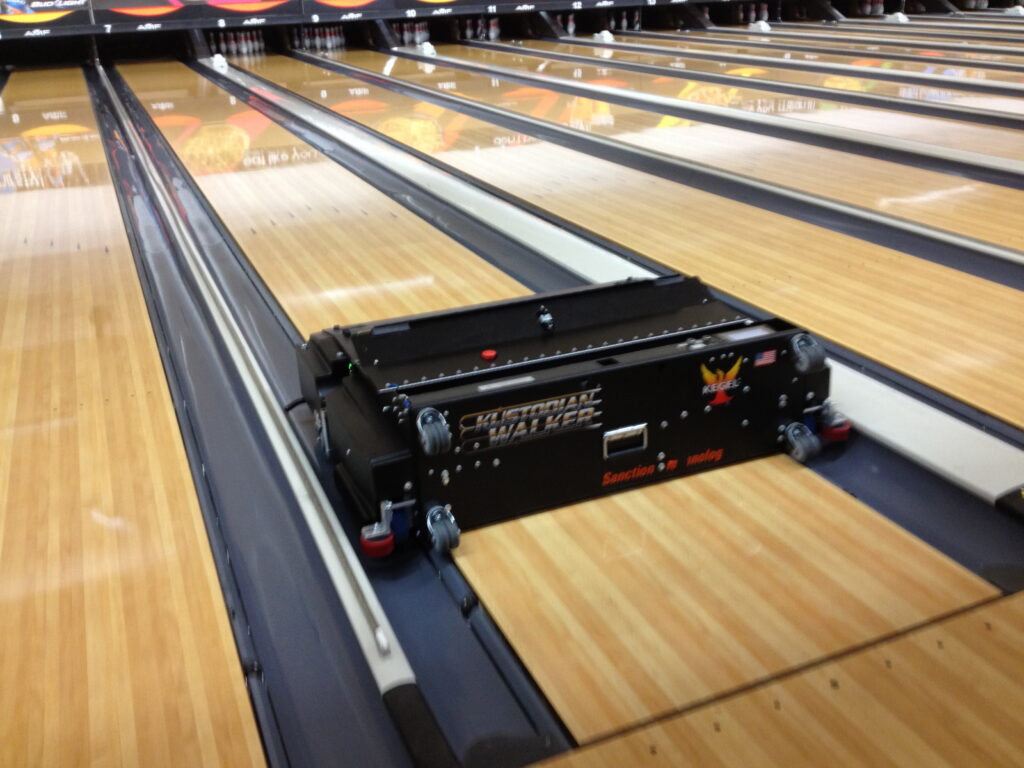
There are a few things that control the way your ball moves as it travels down the lane.
Your armswing and release techniques, of course, are paramount, and the material your bowling ball is made out of also has a major effect. (A plastic house ball will hook much less than a reactive resin ball, for example)
But there’s another less obvious force that also has a big effect on your ball’s movements: the oil on the lane itself.
Lane Conditions Explained
You’ll often hear bowlers talking about lane conditions, but what exactly are they talking about?
Many years ago, bowling alleys started to coat their lanes with oil in order to protect them. This way, bowling balls wouldn’t make large dents on the wood surface.
Today most of the lanes you’ll encounter are synthetic, but the practice of conditioning is still nearly the same.
In addition to a protective role, though, the oil now also serves to add a new challenge to the game.
Oil makes the lane slicker, so it is more difficult for a ball to hook.
Bowling lanes are “dressed” in different oil patterns with certain parts that are wet (coated with a heavier volume of oil) and others dry (little to no oil).
You might compare bowling lane conditions to sand traps and water hazards in golf, but there’s one key exception: you can’t actually see the oil patterns with our own eyes!
Instead, bowlers are constantly playing a guessing game in which they attempt to determine where the oil has been applied so they can adjust their shots accordingly.
House Oil Pattern: It’s On Your Side
Thankfully, bowling lanes use different patterns based on the level of competition, and the basic house pattern that you’ll find at your local bowling alley is actually designed to help you out by facilitating higher scoring.
It is known as a house pattern, and although there are many different varieties, they are all the same basic idea.
In the house pattern, there is more oil in the middle of the lane, and less near the outside. The reason this helps you is as follows.
If you throw a poor shot that veers off course a bit, it will hit the dry outside portion and stop skidding.
There is plenty of time for it to make its way back nearer to the pocket and salvage a decent result.
Conversely, if you hit your shot too far to the inside, the slickness of the center of the lane will guide it back out to the pocket.
All in all, it’s a very forgiving pattern that will do its best to help your shot.
With any oil pattern, straight bowlers have less to worry about, since their shot hooks very little naturally and the lane conditions affect it less.
It’s bowlers who throw a hook who must work hard to figure out their lane so they can make proper adjustments.
Other Oil Patterns
Unfortunately, you won’t always encounter ideal lane conditions.
Some alleys will coat the lanes heavier at the front and less at the back, or little at the front and more at the back.
Watch how long your ball rolls before it starts rotating (known as skidding). If it skids for a long time, then there is a lot of oil on the front of the lane (at least on your side of it). If it does not, then the front is drier.
Conversely, if your ball hooks only a small amount (but you believe your form to be correct), then the lane is wet near the back.
How to Adjust to Bowling Lane Conditions
If your shot isn’t hitting your intended target due to the oil on the lane, you have two options.
First, you can adjust your stance. All you have to do is move your feet by the number of boards that you are missing by, and hopefully your adjustment should correct the error.
You can also switch up your style to match the lane conditions, for example bowling a more straight shot when the lane is wet or a hook if it is dry.
Some bowlers don’t like to mess with their technique, but this is a matter of personal preference.
Your equipment is also an important consideration. When dealing with wet (oily) lane conditions, the best option to still generate friction is a reactive resin ball.
Lane Conditions for Professional Bowlers
Pro bowlers face incredibly tough lane conditions that are intentionally designed to make high scoring difficult.
Most of the PBA’s current patterns are named after exotic animals such as the Cheetah, Viper and Chameleon.
Thankfully, you won’t encounter these unless you enter a competitive tournament.
These advanced patterns are the major reason why it is so difficult to make it as a professional bowler, and most recreational players don’t know it.
This is also why you so often hear someone talking about how they could bowl on the PBA Tour just because they got a few 200s in open bowling at their local alley!
Now that you’ve learned all about lane conditions, you understand a major part of what makes bowling such a nuanced and exciting challenge.